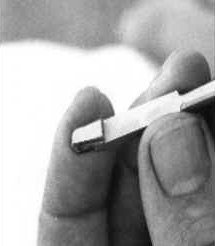- 01: Introduction
- 02: History
- 03: Propellants, Firearms, and Ammunition Development
- 04: Modern Firearms Manufacture
- 05: Small Arms Ammunition
- 06: Evidence Handling Procedures
- 07: Equipment and Instrumentation
- 08: Examination of Firearms
- 09: Cartridge and Shotshell Examination
- 10: Characterization and Evaluation of Fired Projectiles
- 11: Bullet Comparison and Identification
- 12: Gunshot Residue and Distance Determination
- 13: Toolmark Identification
- 14: Communicating Results
- Resources


Cut Rifling
Home > Modern Firearms Manufacture > Rifled Barrels > Cut Rifling
Single Point Rifling

Rifling "hook" cutter
Dating to the earliest days of rifled arms, single-point rifling is the oldest method of grooving the inner surface of the gun barrel. Its name comes from the fact that grooves are cut one at a time. Single-point rifling is still used to make some gun barrels today, including some of the finest quality custom products of the gunmaker’s art.
The process of single pointing a barrel starts with the cutter head, which is a small, separate piece of hardened alloy. A base with a wedge-shaped lower surface supports the part in the tool holder. A single cutting surface protrudes from the top like a tooth, its width determining the groove width of the finished barrel. The tool holder is a round steel cylinder somewhat smaller than the diameter of the bore with a recess or tray to hold the cutter unit. The holder is commonly six to ten times the length of the cutter to provide precision alignment.
The tool holder has a screw-adjustable wedge inside, just below the wedge-shaped bottom of the cutter. This ramp-style engagement allows precision adjustment of the cutter’s height that controls the amount of metal removed. Channels in the tool holder allow cutting oils to flush though the cutting unit during operation, cooling the cutter and flushing out metal chips. The other end of the holder is attached to the drive mechanism of the rifling machine so that it can be pulled through a barrel.
The rifling machine requires two special features to permit barrel production:
- Indexing barrel clamp that allows precise rotation of the barrel for cutting each groove
- Rotating drive mechanism that turns the cutter holder as it moves through the barrel, forcing the grooves to be cut in a spiral pattern
Rifling begins by mounting the barrel in the machine and setting the desired direction and rate of twist. The cutter is adjusted to cut one- to two-thousandths of an inch of metal on each pass. The curved surface of the cutter holder opposite the working edge bears against the side of the barrel for support and alignment.
With setup complete, the power drive drags the cutter through the barrel, producing a very shallow groove. The barrel is rotated to the next index position and the next groove cut. The amount of angular rotation is determined by dividing the number of grooves desired into 360. For a four-groove barrel, the rotation is ninety degrees; a six-groove barrel is rotated sixty degrees, and so on.
After all grooves have received one pass of the cutter, the cutter holder is adjusted to raise the cutter head another one- to two-thousandths of an inch and the process stars over. When the depth of rifling specified in the design drawing is reached, the operation ceases.
Single-point rifling is slower and more expensive than newer methods. However, improvements driven by military needs in the early twentieth century helped to increase the speed and accuracy of the process enough to keep it competitive.
Advantages include
- lowest replacement cost for cutting tools,
- flexibility in rifling characteristics (changes in twist rate, number and dimensions of grooves),
- minimum stress in the barrel,
- quick change-over from one rifling characteristic to another,
- adaptation to steel alloy changes by adjustment only.
Single-point rifling is the method of choice for custom barrel manufacturers that make barrels of many different bore diameters, twist rates, and land/groove characteristics. For large firearms manufacturers that need to build thousands of identical barrels, other methods are more appropriate.




